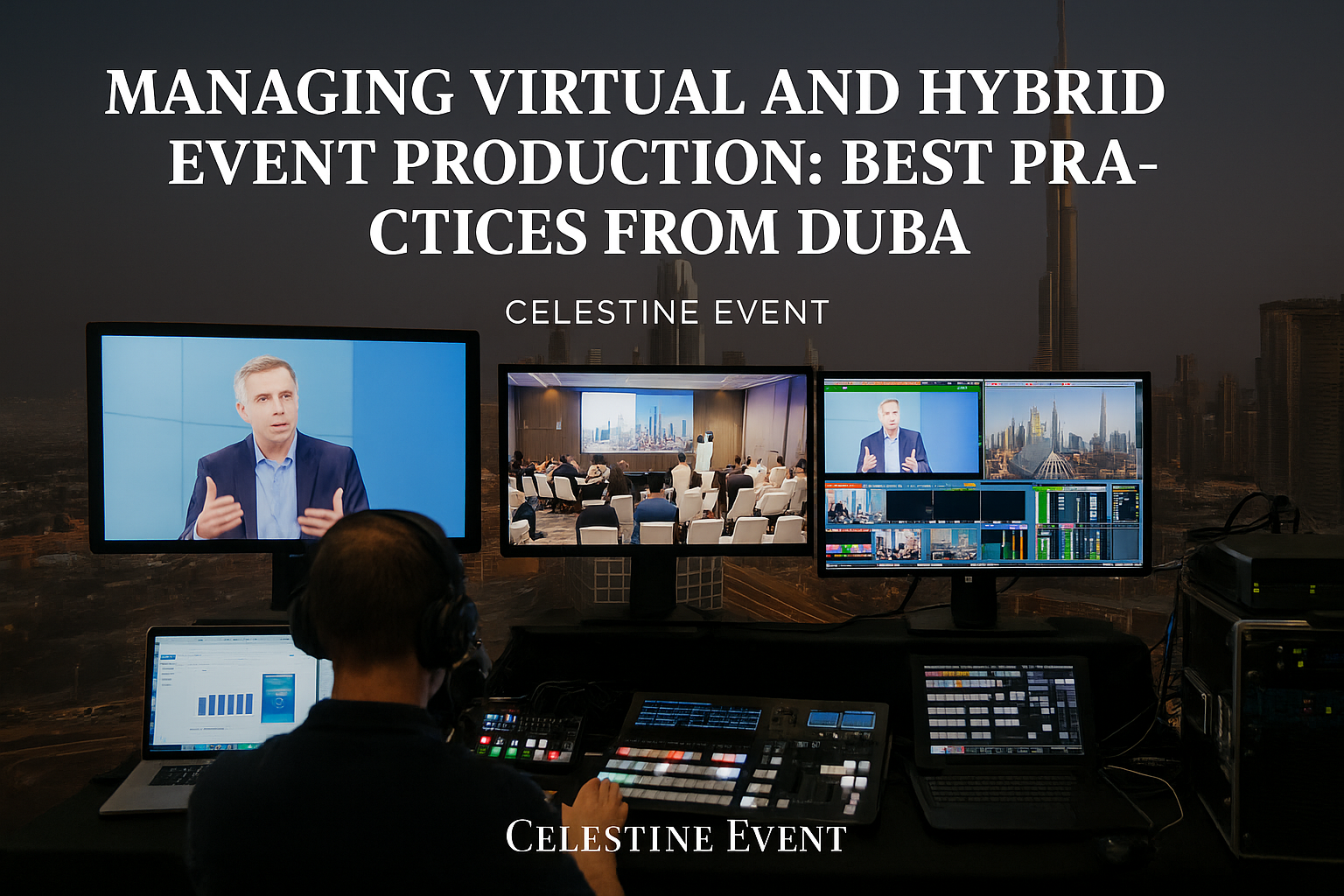
By Celestine Event | High-Impact Event Insights
As Dubai cements its status as a global epicenter for innovation, it continues to lead the charge in virtual and hybrid event production. From international trade expos to global tech summits and luxury brand activations, Dubai-based planners are blending technology, strategy, and cultural fluency to deliver immersive, scalable, and resilient event experiences.
Whether you’re producing a virtual product launch, a hybrid leadership conference, or a global investor summit, here’s a comprehensive guide to best practices that ensure world-class execution from Dubai’s events industry playbook.
✅ 1. Start with a Clear Hybrid/Virtual Event Architecture
Before jumping into tools and platforms, define your event structure:
- Hybrid Format: Will remote and in-person audiences interact? Are sessions exclusive or shared?
- Virtual Format: Is it live-streamed, pre-recorded, or on-demand?
- Engagement Priority: How will both audiences access content and participate in real time?
Map the entire event journey—from invitation to feedback—based on audience behavior and tech preferences.
✅ 2. Select the Right Tech Stack: Local and Scalable
Dubai’s event production experts prioritize reliable, scalable tech platforms that are compliant with UAE cybersecurity and privacy regulations.
Key tools and services:
- Webinar & Virtual Event Platforms: Hopin, ON24, Airmeet, Zoom Events
- AR/VR & Immersive Solutions: VR360 tours for exhibitions, holographic speaker tools
- Content Delivery Networks (CDNs): Ensure global load balancing and buffering-free streaming
- AI-driven Interactivity: Chatbots, voice recognition, and language localization
Pro tip: Choose vendors with local data hosting capabilities for sensitive corporate or government events.
✅ 3. Integrate Seamless Audio-Visual and Broadcast Solutions
Dubai’s leading AV production teams use broadcast-grade setups that combine physical and digital studio environments.
What to ensure:
- Multiple camera angles, remote speaker feeds, and ISO recordings
- Redundant live stream encoders for failover protection
- Dedicated green screens or XR stages for immersive speaker presentations
- Low-latency audio sync for global presenters and simultaneous interpretation
Bonus: Create a branded virtual stage that aligns with your event’s design and sponsor requirements.
✅ 4. Prioritize Accessibility and Localization
Dubai hosts audiences from over 180 nationalities. Make your event culturally and technically accessible:
- Live translation and captioning in Arabic, English, and other key languages
- Time zone-specific session availability
- Multi-device compatibility (smartphones, tablets, desktops)
- Accessible interfaces for attendees with disabilities (screen readers, closed captions)
Incorporate culturally inclusive graphics, attire, and language to maintain brand integrity and respect.
✅ 5. Create High-Impact Content with Multi-Use in Mind
Content is still king—especially when repurposed.
- Use micro-content strategy: segment keynotes, breakout sessions, and Q&As into short, reusable assets
- Include pre-recorded segments to avoid technical hiccups or delays
- Package post-event video libraries for gated lead generation
Tip: Work with local Dubai content teams who understand Middle Eastern business tone and etiquette.
✅ 6. Design Dual-Track Engagement Strategies
Your hybrid event must deliver for two audiences simultaneously—onsite and online.
Strategies to use:
- Live Q&A bridges: Integrate questions from both audiences in real time
- Virtual networking lounges with curated AI-based matchmaking
- Gamified engagement tools: Leaderboards, polls, and sponsor challenges
- Hybrid MCs and moderators: Professionals who engage both audiences fluidly
Engagement parity is key—don’t let your virtual attendees feel like secondary guests.
✅ 7. Set Up Tech Support and Contingency Plans
Top-tier virtual/hybrid events run on real-time monitoring and support:
- Live tech support chat and email for attendees
- Rehearsals with remote speakers and localized internet tests
- A/V & platform backup systems in Dubai and failover to cloud servers
- Dedicated streaming engineers and moderator teams
Risk management isn’t optional—it’s essential in a region known for its precision-driven event execution.
✅ 8. Analyze, Optimize, and Retarget
Post-event, use analytics to optimize your future event strategy:
- Review heatmaps of attendee clicks and watch durations
- Evaluate conversion rates on CTAs and sponsor activations
- Use poll results, feedback forms, and sentiment analysis for actionable insights
- Export segmented lead lists for targeted follow-ups and retargeting ads
Platforms like Hubilo, BigMarker, and Bizzabo integrate with CRM tools to make this seamless.
🎯 Final Thoughts: Dubai’s Hybrid Edge
In Dubai, hybrid and virtual events aren’t seen as backups—they’re brand-building platforms that open global access. With its cutting-edge infrastructure, multicultural talent pool, and relentless innovation, the city offers an ideal model for future-proof event production.
Whether you’re catering to regional markets or global audiences, mastering hybrid delivery is now a core capability—not a nice-to-have.
📌 Pro Tip from Celestine Event:
When planning hybrid events in Dubai, co-produce with a local expert who knows venue capabilities, regulatory expectations, and tech execution inside-out. It saves cost, avoids risk, and elevates impact.